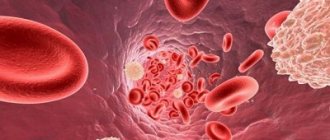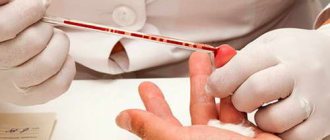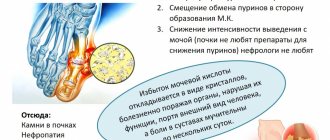What do elevated triglycerides mean?
According to most domestic and foreign experts (in particular, from the AHA - American Heart Association), very high levels of triglycerides, to a greater extent, indicate problems in the LIVER or PANCREAS.
And also at increased risks of developing pre/diabetes and type II DIABETES (due to insulin/resistance, which we will discuss later in this article). IT WOULD BE NICE TO KNOW:
What are (TG) triglycerides and what is their norm for women and men (by age)?
With regards to the direct effect of high levels of TG in the blood plasma in women and men on the risks of developing cardiovascular diseases, the results of modern studies have shown rather contradictory results. Therefore, NOT (!) all experts agree that specifically - an increased level of triglycerides - is one of the main “culprits” of diseases of the heart, brain and blood vessels ( atherosclerosis
).
And there are 2 main reasons for this:
- Firstly
, high levels of TAG (triacylglycerides) in the blood most often appear along with problems such as obesity, hypertension, and diabetes.
And also decreased levels of “good” HDL cholesterol and, conversely, increased levels of conditionally “bad” LDL cholesterol . In this regard, it is quite difficult to determine which problems are caused SPECIFICALLY by the level of triglycerides - ABOVE NORMAL. - Secondly
, recent research results involving patients with a genetic predisposition to high triglyceride levels (familial / hereditary hypertriglyceridemia) have shown that they are NOT (!) at high risk of developing cardiovascular diseases. Although, there is some official evidence that high triglycerides can still play some kind of negative role, BUT (!) Insignificant.
YOU MAY BE INTERESTED IN:
Triglycerides in the blood are low, what does this mean and how to increase them?
Methods for reducing TG
To reduce the concentration of TG in the blood, it is necessary to identify the provoking factors for their increase.
If disturbances in the body occur due to poor nutrition, then a diet with elevated triglycerides and physical activity on the body, or playing sports, will help reduce TG. If the cause is a pathology in the body, then treatment can only be with the help of medications.
Traditional medicine methods can also be used as additional treatment.
Reducing triglycerides with medications
Drugs to lower cholesterol and triglycerides are prescribed as drug therapy:
- Statin medications - reduce the index of low molecular weight and very low molecular weight lipids, and increase the index of high density lipoproteins;
- TG-lowering drugs of the fibrate group - this group of medications suppresses liver cell receptors for the synthesis of low molecular weight lipids that transport TG through the bloodstream. Fibrates are often prescribed together with statins;
- Preparations based on nicotinic acid. This group of drugs works in the body in the same way as fibrates, but also has the properties of increasing the synthesis of high molecular weight cholesterol, which clears the bloodstream of free cholesterol;
- Omega-3 polyunsaturated acids effectively reduce cholesterol and TG, but do not treat the cause of abnormalities in lipid metabolism. These tablets are available over the counter and are the only drug that can be taken independently, without a doctor’s prescription. You just need to strictly follow the instructions for use.
Do not forget that if the concentration of triglycerides is increased, this pathology cannot be treated independently with drugs.
All cholesterol-lowering medications have a large number of side effects on the body, which can cause more harm than good.
All prescriptions for drug therapy are made by the attending doctor.
Folk remedies for reducing TG
You can use medicinal plants to reduce TG only if the increase in cholesterol and TG is not caused by serious pathologies in the body.
For diseases of the endocrine system, it is not possible to reduce the triglyceride index with folk remedies; this therapy can be an addition to drug treatment.
Traditional medicine recipes to reduce a high TG index:
- One spoon (teaspoon) before eating oil from the sea buckthorn plant will help reduce the concentration of TG;
- Drink 100.0 milliliters of beet juice 2 times a day;
- A decoction based on medicinal herbs - St. John's wort (25.0 g), yarrow herb (20.0 g) and mountain arnica (5.0 g). Pour 200.0 ml of boiling water over the collection and let stand for 60 minutes. Drink this drink in one day. Take this decoction for 30 days.
Parsley decoction
Are there tangible signs of impairment?
An increase in the level of triglycerides in the blood is not accompanied by visible manifestations, therefore, before a medical examination, hypertriglyceridemia can only be recognized through the symptoms of existing complications:
- compression and pain in the heart (angina), attacks of shortness of breath (dyspnea);
- heaviness in the right side, palpable enlargement of the liver (hepatomegaly);
Xanthomas around the eyes.
- blurred vision, headache, dizziness;
- excessive psycho-emotional excitability, frequent mood swings;
- persistent increase in blood pressure (hypertension);
- insomnia or, conversely, drowsiness, chronic fatigue syndrome;
- the appearance of yellowish lumps (xanthoma, xanthelasma) on the face or body.
Important! The common belief that with high triglyceride levels, a person will necessarily be overweight is wrong: moreover, hypertriglyceridemia occurs even in people who are underweight. It all depends on the cause of the increase, as well as the individual characteristics of the body.
Physical properties
Fats are viscous liquids or solids that are lighter than water. Their density ranges from 0.9-0.95 g/cm³. They do not dissolve in water, but dissolve in many organic solvents (benzene, dichloroethane, ether, etc.)
Fats are hydrophobic, practically insoluble in water, highly soluble in organic solvents and partially soluble in ethanol (5-10%).
Classification
The higher the content of unsaturated acids in fats, the lower the melting point of fats.
| Physical state of fats | Differences in chemical structure | Origin of fats | Exceptions |
| Solid fats | Contains residues of saturated VKK | Animal fats | Fish oil (liquid when used) |
| Mixed fats | Contains residues of saturated and unsaturated VCC | ||
| Liquid fats (oils) | Contains residues of unsaturated VKK | Vegetable fats | Coconut oil, cocoa butter (solid when unused) |
Nomenclature
According to trivial nomenclature, glycerides are named by adding the ending -ide to the abbreviated name of the acid and a prefix indicating how many hydroxyl groups in the glycerol molecule are esterified.
What does elevated triglycerides mean?
An increase in lipids may be a sign of the diseases described above. Often, a person may not realize they are at risk until they are tested. Elevated triglycerides mean that the patient must follow a diet that will help normalize his blood and lower cholesterol. This also indicates that there is a risk of cardiovascular diseases, liver cirrhosis and hepatitis.
- What are triglycerides in a biochemical blood test?
Elevated blood triglycerides in men
In the stronger sex, the TG level is always slightly higher than in the weaker sex. Elevated triglycerides in the blood in men can occur due to smoking, constant consumption of alcoholic beverages, overeating, and frequent stress. After receiving the test results, you should definitely consult a doctor and undergo a course of treatment.
Elevated triglycerides in women
When it comes to high lipid levels, women are at greater risk than men. Elevated triglycerides in women can occur:
- while taking birth control pills that include the hormone estrogen;
- during pregnancy;
- with polycystic ovary syndrome;
- during menopause;
- for hormonal disorders;
- infertility.
Triglycerides are elevated during pregnancy
An increase in the number of lipids in the mother's blood during fetal development is not uncommon. Many pregnant women have increased cholesterol levels during this period, and this is normal, which cannot be said about triglycerides. The expectant mother will have to reduce the consumption of foods rich in TG in order for the indicators to be normal. If triglycerides are elevated during pregnancy, this does not mean that the development of the fetus is abnormal. Often the reason for this test result is simple overeating or changes in hormonal levels.
Triglycerides are elevated in a child
What does an increase in triglycerides mean? The most common reasons are presented below:
- obesity and excess weight;
- poor nutrition;
- consumption of unhealthy foods (chips, fast food, sweets);
- hereditary genetic abnormalities.
When triglycerides are elevated in a child, the problem becomes more difficult to solve. It can be difficult for children to explain why their parents deny them the usual things. You should force your child or teenager to eat healthy foods and take fish oil. Parents will have to closely monitor the child’s diet and physical activity. In addition, you should consult a doctor and conduct a comprehensive examination of the body.
Medical nutrition and diet
Drug treatment itself is ineffective unless the patient follows a special diet. It's necessary:
- Minimize the consumption of sugar and confectionery products.
- Excluding fast food and semi-finished products.
- You should not eat lard, vegetable oil, or fatty meat.
- Do not overuse eggs (especially yolks) and whole milk, as these products are high in cholesterol.
Be sure to include them in your diet:
- Fresh fruits, vegetables.
- Lean meats and fish.
- Seafood.
- Beans, peas and beans, boiled in water.
- Nuts.
- Fish fat.
- Whole grains.
Often, to normalize blood counts, it is enough to avoid drinking alcohol, smoking and playing sports. Such products are suitable for both therapeutic and preventive purposes.
Features of hypertriglyceridemia in men
The level of triglycerides in men increases with age. Due to the higher content of cholesterol and TG, men more often than women suffer from early coronary heart disease, brain disease, strokes, and myocardial infarction.
Elevated triglycerides in men of all ages are most often a consequence of poor nutrition and bad habits. Other common causes are diabetes, previous myocardial infarction, and kidney disease. Older men with gout have high TG levels.
Lipids
Triglycerides and cholesterol are members of the fat family (also called lipids) but have different functions. Cholesterol is a fat-like substance that is used by the body to produce hormones, vitamin D, and is part of the membrane surrounding cells. Cholesterol is similar to wax and has no odor. The liver produces it from animal products.
Cholesterol and triglycerides in their pure forms cannot mix with the blood. As a result, the liver sends them bundled with proteins called lipoproteins. Lipoproteins move cholesterol and triglycerides throughout the body through the bloodstream ().
There are three types of lipoproteins. These are low-density lipoproteins (LDL), very low-density lipoproteins (VLDL), and high-density lipoproteins (HDL). LDL, also called LDL cholesterol, is considered the “bad” kind of lipoprotein because it contributes to the buildup of plaque in the arteries. HDL cholesterol is considered "good" cholesterol because it removes LDL from the arteries ().
Normal levels of triglycerides in the blood of women and men
| Patient age | |
| Under ten years old | M 0.340 - 1.130 |
| F 0.40 - 1.240 | |
| From ten to fifteen years | M 0.360 - 1.410 |
| F 0.420-1.480 | |
| About fifteen to twenty years old | M 0.420 - 1.670 |
| F 0.440 - 1.40 | |
| Twenty to twenty-five years old | M 0.50 - 2.270 |
| F 0.410 - 1.480 | |
| Twenty-five to thirty years old | M 0.520 - 2.810 |
| F 0.420 - 1.630 | |
| Thirty to thirty-five years old | M 0.560 - 3.010 |
| F 0.440 - 1.70 | |
| From thirty-five to forty years old | M 0.610 - 3.620 |
| F 0.450 - 1.990 | |
| Forty to forty-five years old | M 0.620 - 3.610 |
| F 0.510 - 2.160 | |
| Forty-five to fifty years old | M 0.650 - 3.70 |
| F 0.520 - 2.420 | |
| Fifty to fifty-five years old | M 0.650 - 3.610 |
| F 0.590 - 2.630 | |
| Fifty-five to sixty years old | M 0.650 - 3.230 |
| F 0.620 -2.960 | |
| From sixty to sixty-five years old | M 0.650 - 3.290 |
| F 0.630 - 2.70 | |
| From sixty-five years old | M 0.620-2.940 |
| F 0.680 - 2.710 |
It should be noted that the norm of triglycerides in the blood of women after 50 years increases and approaches the “male norm” due to the onset of menopause and changes in hormonal levels.
- Reactive arthritis in a child, have you ever encountered this?








